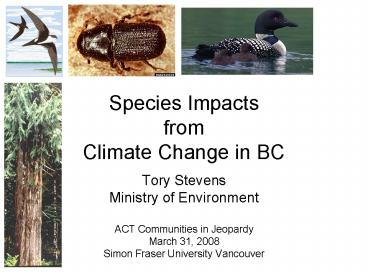Species Impacts from Climate Change in BC - PowerPoint PPT Presentation
1 / 29
Title:
Species Impacts from Climate Change in BC
Description:
Oct 2004 BC Trust for Public Lands announced to support biodiversity ... Cassin's Auklet 1978 - 1999. Data from Doug Bertram, SFU. First Nations observations ... – PowerPoint PPT presentation
Number of Views:39
Avg rating:3.0/5.0
Title: Species Impacts from Climate Change in BC
1
Species Impacts from Climate Change in BC
- Tory Stevens
- Ministry of Environment
- ACT Communities in Jeopardy
- March 31, 2008
- Simon Fraser University Vancouver
2
Outline
- What is Biodiversity BC?
- What is the Status Report?
- Terrestrial realm
- Freshwater realm
- Marine realm
- Traditional phenological knowledge
3
Biodiversity BC Chronology
- Oct 2004 BC Trust for Public Lands announced to
support biodiversity conservation - BC Conservation Lands Forum established as a
government-ENGO partnership to manage Trust - CPTC created as an independent committee under
Forum to develop B.C. biodiversity strategy - 2005 CPTC established - governance framework
and science foundation initiated - 2006 Biodiversity BC set up as the
organizational entity responsible for developing
biodiversity action plan including steering
committee, secretariat and 2 main subcommittees
(technical and plan development)
4
Biodiversity BC The Status Report
- An overview of the current status of biodiversity
in British Columbia including
5
Framework
- Levels of organization genes, species,
ecosystems - Realms Terrestrial, Freshwater Aquatic, Overlap
with Marine - Biodiversity attributes composition, structure,
function
6
Terrestrial Realm
- Yellow cedar, Western redcedar, Grand fir
- Dothistroma
- MPB
- Birds
- Mammals
7
Yellow Cedar Decline in Crow Lagoon, BC
8
Western Redcedar and Grand Fir
- Susceptible to summer drought
- Pattern of decline in areas that have shallow
soils - Grand fir began dying about 5 years ago in the
municipalities on southern Vancouver Island - Western redcedar is dying all along the east
coast of VI pronounced branchlet drop
9
Dothistroma septosporum
- Fungus that causes needle blight in pines
- Dramatic increase in incidence in NW BC including
extensive mortality in pine plantations
Alex Woods
10
Dothistroma
- Coincides with increased frequency of warm rain
events in summer - Climate trend is more likely part of directional
global change not decadel oscillation
Alex Woods
11
Summer Trends 1971-2000
12
Mountain Pine Beetle
- By 2006, effects of climate change had expanded
suitable MPB habitat by 75 - These changes are continuing
13
Winter Minimum Temp. Trend1971-2000
14
Birds
- Timing changes
- Range changes
White-throated swift
15
Earliest arrival Common Loon (interior B.C.,
53º - 55º latitude)
r2 0.57 p lt0.001
Source Bunnell, F., K. Squires, M. Preston and
W. Campbell 2007
16
Arrival Departure Times
Arrival
Departure
17
Yellow Warbler - Change in Relative Abundance
1960s
1990s
sampled, no Yellow Warbler
Relative Abundance
not sampled
18
Range changes
- 25 birds found in BC in 2006 that were not here
in 1947 - Climate changes (drying of habitats to south
warmer winters in the north) - Still reinhabiting formerly glaciated landscape
- Well adapted to human modified landscapes
- From Quayle, Ramsay, and Fraser 2007
19
Mammals
- Pika
- Nevada and California (USA)
- White-tailed deer, cougar, bobcat
- Expanded range
20
Aquatic Realm
- Sockeye salmon - Early Stuart run
- Eulachon
21
- Location of Stuart Lake system
Cottonwood dugout canoe in Fraser Lake circa 1908
22
Early Stuart sockeye timing
- Migration time has shifted 5 days due to warmer
sea surface temperatures - Corresponds to earlier seasonal maximum river
flow - When flow recedes, water temperature rises to
stressful levels causing disease outbreaks
Trend in peak date of passage of Early Stuart
sockeye past Hells Gate (Macdonald et al. 2000).
23
Migration Success
- Summer Run Sockeye and Temperature at Hells
Gate, 1978-1998
Source Indicators of Climate Change for BC. MOE.
2002.
24
Eulachon
- Eulachon abundance has declined in many rivers
throughout their distribution in recent years. - Sudden drop in returns to several rivers in 1994,
most notably in the Fraser and Columbia. - Eulachon have virtually disappeared in California
and in the last two years they have not been seen
in several BC rivers -- Stikine, Unuk, Skeena,
Kitimat, Kemano, Kitlope, Bella Coola, Kimsquit,
Owikeeno, and Kingcome Rivers.
25
Eulachon Decline
- Trawl fishery
- Increased predation
- Alterations to river hydrology due to logging
- Climate change
- Combination of the above
26
Marine Realm
- Macroalgae
- Dictyoneuropsis reticulata
- Common in California
- Jane Watson not present in 1991 in the Goslings
reported in 1994 most abundant kelp in 2007 - Eisenia arborea
- Considered a more southern species
- Jane Watson absent in 1991 approximately 20 of
stalked kelps in 2007
27
Cassins Auklet 1978 - 1999
Data from Doug Bertram, SFU
28
First Nations observations
- Traditional phenological knowledge
- Phenological cues for judging harvesting times
and seasonal animal movements plant growth,
flower blooming, bird song, insect hatch - Gitgaat of Hartley Bay use nettle growth to
judge readiness of red laver seaweed for harvest - From Turner and Clifton 2007
29
Summary
- Species are only part of the story
- Interactions are all affected
- Ecosystems shift
- Structures altered
- Functions are disrupted































